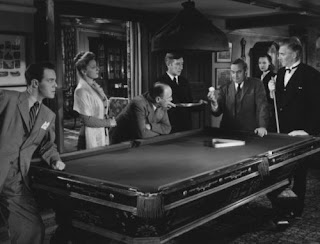Eight strangers are invited to spend a week at the secluded island home of Mr. and Mrs. Owens. They are met by the Owens' new servants, butler Thomas Rogers (Haydn) and his wife Ethel (Leonard), who is the cook. The Owens' are away, but are expected to join the group for dinner.
At dinner, they notice the centerpiece: ten Indians in a circle and recite the corresponding nursery rhyme. That evening, via a gramophone recording, Mr. Owens' accuses everyone of murder:
- Judge Francis Quincannon (Fitzgerald) of sentencing an innocent man to death
- Dr. Edward Armstrong (Huston) of causing a patient's death
- Philip Lombard (Hayward) of killing 21 East African tribesmen
- Vera Claythorne (Duprez) of the death of her sister's fiancé
- Prince Starloff (Auer) of killing two people
- General John Mandrake (Smith) of sending his wife's lover to be killed in battle
- Emily Brent (Anderson) of the death of her nephew
- William Blore (Young) of perjury, which caused the death of an innocent man
- Thomas and Ethel Rogers of killing an employer so they could inherit her money.
They learn that no one, including the Rogers', have met their hosts. They also learn that they are stuck on the island until the boat returns on Friday and there is no way to reach anyone off the island.
They ignore the warning, until the guests begin dying, in a manner matching the nursery rhyme. They search the house and grounds and cannot find anyone else on site. As the bodies begin piling up, can they identify the murderer and escape the island?
The story is based on Agatha Christie's 1939 novel "And Then There Were None". It is one of Christie's most popular novels, and one of the best crime novels ever. Christie adapted the novel to a play in 1943 and changed the ending. Most of the adaptations use the play ending, instead of the novel ending.
The Good:
The film, shot in black and white, makes the most of shadows to heighten the suspense. The script sticks close to Christie's novel. There is a nice mix of suspense, mystery, and some humor to keep the film from getting too dark. The story sets a decent pace and does not waste any of it's runtime.
The cast is good, with Walter Huston's Dr. Armstrong as a highlight/standout.
The Bad:
The cast is fine, but some characters are annoying.
Other Comments:
-This is the first (of many) film adaptations of the novel. It is also considered the best of the bunch.
-The film is well-done and enjoyable... and it makes me want to read the novel again.
And Then There Were None (1945) 97 minutes
Director: Rene Clair
Starring: Barry Fitzgerald as Judge Francis Quinncannon
Walter Huston as Dr. Edward Armstrong
Louis Hayward as Philip Lombard
June Duprez as Vera Claythorne
Roland Young as Detective William Henry Blore
Mischa Auer as Prince Nikita Starloff
C. Aubrey Smith as General John Mandrake
Judith Anderson as Emily Brent
Richard Haydn as Thomas Rogers
Queenie Leonard as Ethel Rogers
Harry Thurston as Fred Narracott







0 comments:
Post a Comment